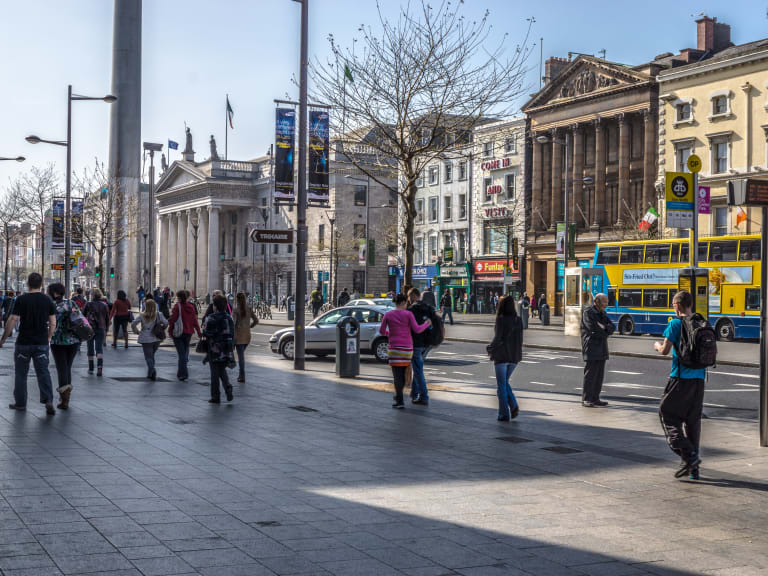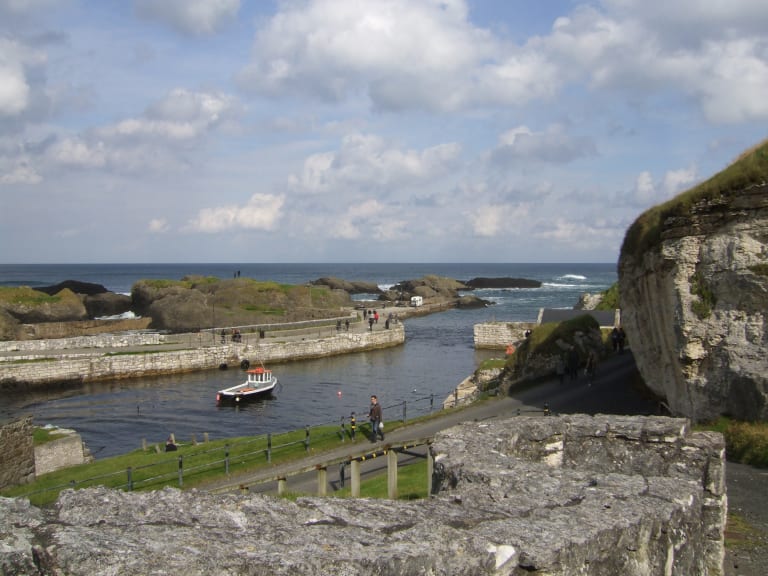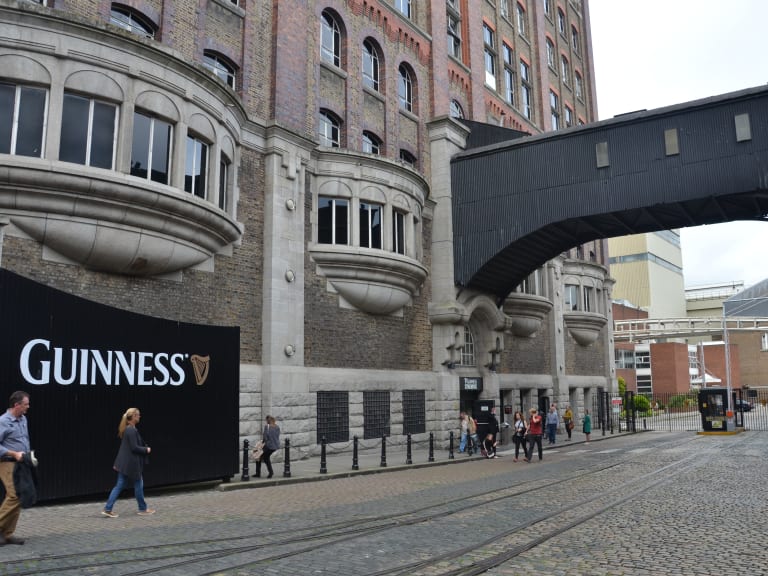More about: Dublin in 3 Days: tips, what to see, and much more
A two-day stay in the Irish capital will give you the opportunity to visit the most important among the many things to see in Dublin. Thanks to the fact that its size is not too big, those 72 hours will allow you to see a good part of its attractions.
In addition, I also include in this itinerary an excursion that will give you the opportunity to tour the capital and at the same time have a taste of the Irish countryside. If you are a fan of "Game of Thrones" you will appreciate it even more....
Day 1: Dublin Essentials

The first day of your stay in Dublin will be spent getting to know its main attractions. A great advantage of this itinerary is that you won't have to leave the center to do it, so it's perfect for walking the whole way.
Try the Irish breakfast
The full Irish is the traditional breakfast of the island. The ingredients and the name may vary a bit depending on the area - for example, in nearby Belfast it's known as "Ulster fry" - and one of the best places to try it is The Woollen Mills. This establishment is located at 42 Lower Ormond Quay, near the Ha'penny Bridge and the River Liffey.
If you are wondering, the local breakfast consists of the following ingredients: bacon, sausages, black and white pudding, eggs, fried potatoes in butter, homemade Irish soda, brown bread and a cup of tea such as Barry or Lyons.
After tasting it, follow the riverbank towards the sea until you reach the next point on the itinerary.
Walk along O'Connell Street
This central Dublin street is home to three of Dublin's must-see landmarks: The Spire (a giant metal obelisk), the post office and the monument dedicated to Daniel O'Connell O'Connell, a 19th century Irish hero.
Strolling on its wide sidewalks is a pleasure, there are always people walking along it to go shopping or have a drink in the cafes and restaurants.
Visit the oldest university in the country

Cross the river and follow the signs to Trinity College. In a few minutes you will reach your destination. Founded in the 16th century, it is still a university, but you can visit it by booking a guided tour on the official website.
Writers of the caliber of Oscar Wilde and Bram Stoker trained here, strolled under the Bell Tower and along Library Square. You will see the historic library that houses the famous "Book of Kells", a manuscript hand-illustrated by the monks of Kells.
Admire the figure of Molly Malone
Legend and a popular song tell that Molly Malone was a seafood street vendor. She was known for her beauty and met her death from a bad fever. Since then, her ghost has been wandering the streets of the city.
If you've had a pint in any of Dublin's best pubs, you'll almost certainly have heard the ballad as it is Ireland's unofficial anthem. On Suffolk Street, a bronze statue portrays the woman with the cart she used to sell cockles and mussels.
Enter the National Cathedral of Ireland
This medieval building dates from the 13th century. It stands on the same site where there was a well believed to have been used by St. Patrick. Despite its age it retains the original Gothic appearance. Its main charms are the stained glass windows, marble statues and medieval mosaics.
Guided tours are held regularly and if you want to book one, I recommend you take a look at the Cathedral's website.
Take a stroll through the Portobello neighborhood
This area of the city is dotted with bars, cafes, stores and new establishments. It is such a trendy area that The Irish Times newspaper has defined it as "Hipsteria Lane". You can take a stroll through the Iveagh garden (it has a small labyrinth) or walk the paths of the wonderful St Stephen's Green Park.
If you feel like it, you can end the day with a tour of the Teeling Distillery (Newmarket 13/17) or treat yourself at Bastible, a modern restaurant with vegetarian options (South Circular Road 111).
Day 2: The sets of "Games of Thrones"

On the second day, wake up early. Generally, tours depart between 6:30 and 7:00 from a central location in Dublin and head north.
In fact, the attractions on this tour are not in the Republic of Ireland but in Northern Ireland. The first stage is a mythical place of the island: the Giant's Causeway.
A famous stretch of coastline
The Giant's Causeway (Giant's Causeway in English and Clochan Ain Afir in Celtic) is an essential stage of any trip in Ireland. It is a basalt promontory on the northern coast of Northern Ireland.
According to legend, the geological formation arose thanks to the joint action of two giants: the Irishman Finn McCool and the Scotsman Bennandoner. When they were at loggerheads, they threw some rocks into the sea and, gradually, a walkway was formed between the two coasts.
Normally, this stage lasts between one and two hours. You will have enough time to do one of the two routes; the green one will take you to the top of the cliff while the blue one goes to the columns of the Calzada de los Gigantes. Take advantage of your stay to take some panoramic photos.
Ballintoy Harbour
With a little imagination you can visualize Pyke Harbour in the Iron Islands. This is the home of Theon and Yara Greyjoy in Games of Thrones.
In real life, it was a fishing port and a place frequented by smugglers. It is a popular destination, as this stretch of coastline is of rare beauty. The photos you can take here are going to triumph on social networks.
The fortress by the sea

The ruins of Dunluce Castle are located in the village of Bushmills, a short distance from the Giant's Causeway. Although its origin is older, what remains of the fortress dates back to the 16th and 17th centuries, when it was inhabited by two feuding clans: the McQuillans and the MacDonnells.
Dunluce has been the backdrop for several historical events: in the 16th century, a Spanish galleon sank on the nearby rocks, inspired "The Chronicles of Narnia" and belonged to Winston Churchill.
Undoubtedly, most people know it from its appearance in Game of Thrones. In the HBO series, Dunluce is the residence of the Greyjoys, the kings of the Iron Islands.
The bus stops near the castle and you'll have plenty of time to wander around and take some photos. If you arrive in the morning you will be able to capture the most evocative atmosphere. Early in the morning, the mist rising from the sea envelops the ruins creating a fairytale atmosphere.
Take a stroll through Belfast
The capital of Northern Ireland is a city that was reborn after years of conflict. Its renewed tourist vocation is evident in the Harland and Wolff shipyards that currently house the Titanic Museum. The famous ship was built in these docks and a visit will give you the opportunity to learn about its history.
Other attractions in Belfast are its murals, the Castle, St. Anne's Cathedral or the Botanic Gardens. After an hour and a half, the bus will take you back to Dublin.
Warm up with an Irish stew

After such an intense day, you should recharge your batteries with a classic of the local cuisine: Irish stew. It is usually eaten throughout the year although it is a typical dish of St. Patrick's Day, the feast celebrated on March 17.
The traditional stew is made with lamb, two types of potatoes (usually King Edward and the Desirée or Pentland Javelin variety), carrots, onion and spices (bay leaf, parsley, fresh thyme and black pepper).
Fortunately, Dublin has a few restaurants where it is prepared to perfection:
- O'Neill's, a Lonely Planet favorite. The establishment has been praised for its authentic Irish food. It is located in the heart of the capital within walking distance of the Molly Malone statue (2 Suffolk Street).
- The Brazen Head, the doyen of Dublin. It was founded in the 12th century and almost a thousand years later still serves as an inn. Its name translated would be "bronze head" and comes from a legend of the thirteenth century. According to the myth, in its surroundings was a bronze face that could foretell the future (Lower Bridge Street 20).
- Gallagher's Boxty House, one of the best restaurants in town (Temple Bar 20/21)
- Old Mill, a restaurant specialized in traditional food. In addition to the Irish Stew, you can order Wicklow Lamb Shank (roast leg of lamb), Dublin Coddle (a casserole with potatoes, sausages, bacon and onions) and Cottage Pie, the veal pie that sweeps Ireland and the UK (Temple Bar 14).
- The Hairy Lemon, an unconventional place housed in a 19th century building. After the stew you can conclude your dinner with a shot of whiskey. They have a wide selection of Irish bottles (Stephen Street Lower 41/42).
Day 3: Nature and beer

Ireland is a green paradise and there is no shortage of places to connect with the land. One of the most famous is the Phoenix Park.
Lose yourself among forests and meadows
Although it is located a few kilometers from the center, Phoenix Park will transport you to the Irish countryside. Getting there is easy, just take the bus (lines 25, 26, 37, 38, 39, 46A and 70) or the train (Heuston is the nearest station). Note that most of the tour buses stop here.
Phoenix Park is home to a large colony of fallow deer. These animals are not native to the island, but were introduced by the Normans in order to populate the Royal Forest.
You can see them in the meadows at the foot of the Papal Cross (a steel cross commemorating the visit of Pope John Paul II) and in the vicinity of the American embassy. However, the park is very large and the fallow deer are often on the move. It is forbidden to feed them but you can admire them respecting the distances.
Take the morning to walk the trails and photograph the best spots. If you want to move faster, you can rent a bike or a tandem.
The park includes points of interest such as Fort Magazine, The People's Gardens (a Victorian-style gardens), a prehistoric tomb, Ashtown Castle and the Wellington Monument.
Try a typical recipe
Walking stimulates the appetite and no trip to Ireland is complete without trying fish and chips. Cross the river and head towards Christ Church Cathedral, near the church is a city institution: Leo Burdock.
When Dublin was shaken by the 1916 uprising, this bodega was already serving fish and chips. Its premises are very popular and have been visited by Tom Cruise, Bruce Springsteen and U2. It celebrated 100 years of age in 2013 and its vinegar still marries splendidly with fish and chips.
Enter a Dublin landmark

A short stroll is the ideal way to digest lunch. Before reaching the next stage you have to walk for about twenty minutes.
The Guinness Storehouse saw the light in 1904 and continued to operate until 1988. Today it is a museum and a popular attraction.
The visit begins on the second floor where you will find the famous 9000 year lease; in fact, in 1759 Arthur Guinness signed a lease of the St. James's Gate Brewery at an annual rent of £45.
On the seventh and top floor you can enjoy a pint in the Gravity Bar which offers one of the best views over Dublin.
If you visit the Irish capital in March you can celebrate St. Patrick's Day at St. James's Gate Street Warehouses. On these dates, the Guinness factory is animated with music, food and typical dances. Admission includes a pint of the licorice-colored drink. I also recommend a visit during the Christmas season.
In December, the factory hosts a wonderful Christmas tree, there are concerts and you can enjoy a special menu with special edition Christmas pints.
Is it worth visiting Dublin in three days?

In my opinion, three days is a perfect stay. The capital of Ireland is not excessively large and moving from one corner to another is very easy. Organizing well the activities you can see the essential of Dublin and a snack of the surroundings.
Ireland is a beautiful country and if you want to visit Galway or Cork, I recommend you to dedicate at least five days to the trip.



